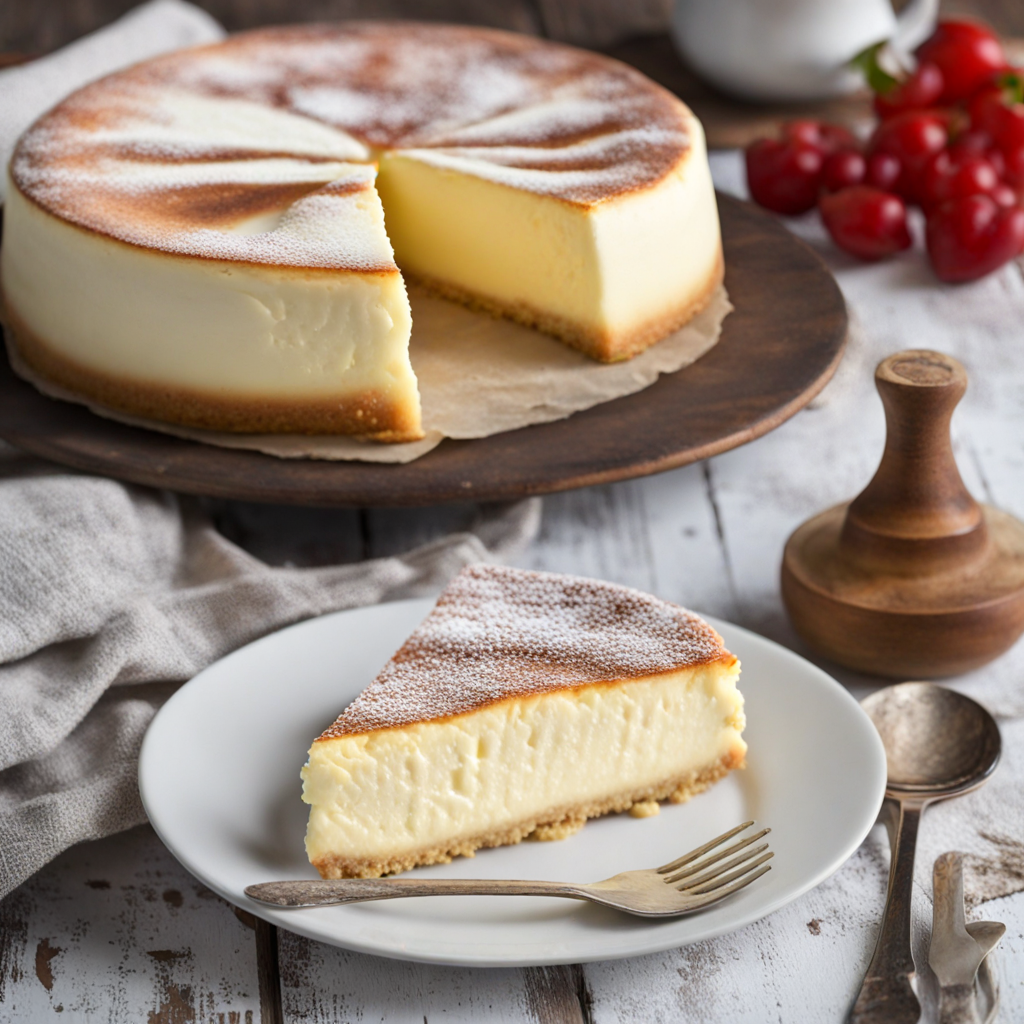Sernik
Sernik, a traditional Polish cheesecake, captivates with its unique texture and flavor profile that is distinct from other cheesecakes around the world. Made primarily from twaróg, a type of fresh curd cheese, Sernik boasts a rich, creamy consistency that melts in your mouth. This cheese is combined with eggs, sugar, and often a hint of vanilla or lemon zest, creating a delightful balance of sweetness and tang. The crust typically consists of crushed biscuits or a simple shortcrust pastry, providing a satisfying crunch that contrasts beautifully with the velvety filling. The baking process of Sernik is equally important, as it is often baked in a water bath to ensure even cooking and a smooth texture. This gentle method helps to prevent cracks on the surface, resulting in an elegant presentation. The top may be lightly browned, hinting at the delightful caramelization of the sugars which adds depth to the flavor. Each bite reveals a harmonious blend of the creamy cheese, subtle sweetness, and the aromatic notes from the added zest or vanilla, making it a truly indulgent dessert. Sernik can be enjoyed in various forms, from classic recipes adorned with fruit toppings like strawberries or blueberries to more modern interpretations featuring chocolate or nuts. It is a beloved dessert during holidays and family gatherings in Poland, often served with a dollop of sour cream or a sprinkle of powdered sugar. Whether enjoyed warm or chilled, Sernik offers a delectable experience that invites both locals and newcomers to savor the rich culinary heritage of Poland.
How It Became This Dish
The History of Sernik: Poland's Beloved Cheesecake #### Origins and Early Influences Sernik, the beloved Polish cheesecake, has a rich history that reflects the cultural tapestry of Poland. Its origins can be traced back to ancient times when cheese was a staple in the diet of many European cultures. The use of cheese in desserts can be seen in various forms across the continent, but the specific evolution of sernik is deeply rooted in Polish tradition. The earliest versions of sernik likely emerged in the Middle Ages, a period marked by the influence of both local and foreign culinary practices. During this time, Poland was a melting pot of cultures due to its central location in Europe, which facilitated trade and cultural exchange. Historical records indicate that the Polish nobility enjoyed cheesecakes, often flavored with local ingredients and spices, and prepared using simple methods that highlighted the quality of the cheese. The term "sernik" itself is derived from the Polish word "ser," meaning cheese. Traditionally, sernik was made with twaróg, a type of fresh cheese similar to ricotta or cottage cheese, which is a staple in Polish households. Twaróg's mild flavor and creamy texture made it an ideal base for the cheesecake, allowing for a variety of flavorings and toppings. #### Cultural Significance Sernik holds a special place in Polish culture, often associated with family gatherings, celebrations, and religious holidays. It is particularly popular during Christmas and Easter, where it is featured on festive tables alongside other traditional dishes. The preparation of sernik can be a communal activity, with family members coming together to create their version of this cherished dessert. The significance of sernik extends beyond its taste; it is a symbol of hospitality and tradition. Offering sernik to guests signifies warmth and generosity, making it a staple in many Polish households. The cake has become a comforting presence in the lives of many Poles, evoking memories of home and family. #### Evolution Through Time As Poland underwent various political and social changes over the centuries, so too did the recipe and preparation of sernik. The 19th century was a period of culinary exploration in Poland, as the country sought to define its national identity amidst the influences of neighboring cultures. During this time, sernik began to take on different regional variations, each reflecting local tastes and ingredients. In urban areas, particularly in Warsaw and Kraków, bakers began to experiment with sernik by incorporating rich flavors such as chocolate, fruit, and nuts. The use of different types of cheese also became more common, with cream cheese and mascarpone making their way into recipes. These innovations not only modernized the dish but also made it accessible to a broader audience. The interwar period saw sernik gain further popularity, especially as Polish women began to take more active roles in both the domestic sphere and the workforce. Cookbooks began to feature sernik prominently, providing various recipes that ranged from traditional to more contemporary interpretations. The popularity of sernik soared, leading to its establishment as a quintessential Polish dessert. #### Sernik Today: A Modern Interpretation In contemporary Poland, sernik remains a beloved dessert, enjoyed both at home and in cafes. It has become a symbol of Polish culinary heritage, transcending generations. Today’s bakers continue to honor traditional recipes while also embracing modern techniques and flavors. Modern sernik often features a crust made from crushed biscuits or graham crackers, a departure from the traditional baked approach. Toppings may include fresh fruits, caramel, or chocolate ganache, allowing for endless customization. Additionally, variations such as tzatziki, a lighter version made with yogurt, have emerged, catering to health-conscious consumers. The rise of social media and food blogging has also played a role in the resurgence of interest in sernik. Home bakers share their interpretations, showcasing the versatility of the dish and inspiring others to experiment with their own flavors. This renewed enthusiasm for baking has led to sernik being featured in various competitions and culinary events, solidifying its status in Polish gastronomy. #### Sernik's Global Reach As Polish communities have spread across the globe, so too has sernik. In countries with significant Polish populations, such as the United States, Canada, and the United Kingdom, sernik has become a staple in Polish delis and bakeries. It is often served at cultural festivals and gatherings, allowing expatriates to connect with their heritage through food. Moreover, the globalization of cuisine has led to increased interest in traditional Polish dishes among non-Poles. Sernik has been embraced by food enthusiasts worldwide, often appearing on dessert menus and in culinary blogs. This international recognition has not only helped preserve the dish but has also allowed it to evolve further, as chefs and home bakers experiment with fusion flavors and techniques. #### Conclusion: A Legacy of Love and Tradition Sernik is far more than just a dessert; it is a symbol of Polish identity, community, and love. Its evolution from a simple cheese-based dish to a beloved staple in both Poland and beyond exemplifies the resilience and adaptability of cultural traditions in the face of change. As sernik continues to be baked and shared in homes and cafes around the world, it serves as a delicious reminder of Poland's rich culinary heritage. From its humble beginnings to its modern interpretations, sernik encapsulates the essence of Polish hospitality and the enduring power of food to connect people across generations and cultures. Whether enjoyed in its traditional form or reinvented with new flavors, sernik remains a cherished part of Poland's culinary legacy, inviting everyone to partake in its sweet history.
You may like
Discover local flavors from Poland







